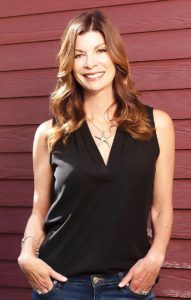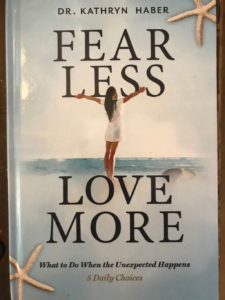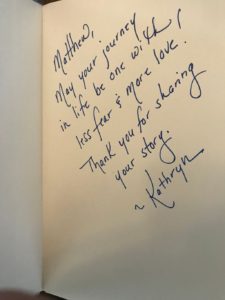An interview with Dr. Kathryn Bowker Haber, author of the book “Fear Less Love More: What to Do When the Unexpected Happens”
Part One: Diagnosis

Trauma, I found, can make you feel isolated and lonely. The feelings – anxiety, stress, paranoia, panic, anger – that come from trauma can make you feel separated from the people around you. It is difficult to explain, but if I learned anything from the events of 2012, when my son Aidan died of an accident two weeks after I was diagnosed with leukemia, it’s that we’re all dealing with something awful that has irrevocably changed us in ways we may never fully appreciate or even know.
So, when I got the message from my high school classmate, Dr. Kathryn Bowker Haber, a clinical psychologist specializing in organizational psychology, that she wanted to use the story of Aidan’s Playground – a memorial to my late son in the town of Littleton, Massachusetts – in her book I was proud. Aidan’s Playground, for me, is a wonderful story about something good growing out of something horrible.
It also made me want to chat with Kathryn. She had dealt with her own tragedies. They came in the form of the loss of multiple family members to cancer as well as her fight with lymphoma. Plus, her book was about looking at a world that is, at best, unfair and unjust, with love and compassion.
That impressed me, and I felt it would be good for the soul to sit and talk to her about her experiences and see how they were the same and how they differed. I also just wanted to talk to someone who had been through something similar to my family. So, just before Christmas we had a nice, long conversation and at the end of it, I felt less alone. I hope, after sharing some of our conversation, you might feel the same.
In Part One, Kathryn and I reflect on how we were diagnosed with our various cancers and how we dealt with treatment, which had its similarities and differences. We both had in common that it took multiple trips – three apiece – to the doctor to get a diagnosis.
The Call
Because of her family history of cancer, Kathryn would regularly to an oncologist based in Denver, where she lives. She said she noticed an enlarged inguinal gland.
“Like you, I went back three times,” she said, “and my oncologist wasn’t concerned about it because I didn’t have any of the other symptoms associated with lymphoma.”
When she got the initial call, she was holding one of her twins on her hip. Kathryn said the oncologist said he was wrong, that she did have lymphoma.
“But” she said: “but it was a type that you have is a just wait and see because it’s not curable, but you know, we don’t do any sort of treatment. We just wait and watch it.'”
“So, I hung up the phone, and I wondered, okay, well, it’s not treatable or it’s not curable, that doesn’t feel good. But I don’t have to go through chemo and radiation, which was appealing,” she said.
“Then I get a call back a couple of minutes later, and he said, ‘Sorry, I was wrong. You have the curable type, but you do have to go through chemo and radiation.'”
Her Lymphoma type was: Follicular Lymphoma, Grade 3, Stage 1, which Kathryn said was aggressive, but had a 93% survival rate.
Back to Boston
“He just didn’t have a good bedside manner at all,” she said of her Denver oncologist. “And when I asked him about my type of cancer that I had, he actually handed me a medical article that Arnie Freedman wrote. He said, ‘This is what you have.'”
After her experience in Denver, Kathryn decided to relocate to Boston and Dana-Farber for her treatment. Ironically, it was Arnie Freedman, the author of the article that would become her doctor at Dana-Farber Cancer Institute. At Dana-Farber, she said she had that feeling of being part of a team fighting cancer together.
“So, I couldn’t wait to get back home and be with family. And then also be part of the Dana Farber community,” she said.

And “community” is the word that comes to mind when I think of DFCI. On my first trip to Dana-Farber, I saw the size of that community firsthand. I entered an exceptionally large building packed with patients and professionals working towards the same goal: treating and eradicating cancer.
Third Time’s a Charm
My experience was identical in some ways and quite different in others. I went to Lahey’s Hospital’s walk-in center twice with extreme back pain. The first two times, the same doctor gave me Vicodin and told me to be patient; that back pain took weeks, if not months, to heal.
Then I started having night sweats, and I doggedly returned a third time and got a new doctor.
“Look, I’ve here twice,” I said, “and I have to tell you: something’s really wrong with me, OK?”
He gave me blood tests and had me admitted immediately. Why I wasn’t given blood tests before, I have no idea. Two days, and a bone-marrow biopsy later, a Lahey Hospital and Medical Center hematologist, delivered the news.
I do not know if there is a “good” way to tell someone they have acute lymphoblastic leukemia, but my hematologist managed to drop the bomb with a certain amount of optimism and grace.
We know how to treat this, he said. You’re going to look back on this moment in five years, in ten years, and you’re going to be a survivor.
“But now,” he said, “we have to get to work treating you.”
When word of my diagnosis got out, a member of the Winchester Boat Club, where I had worked for six summers as a manager, immediately got in touch with my parents. She gave them the name of a doctor at Dana-Farber Cancer Institute, and after initial chemo, I would go to DFCI for further evaluation and treatment.
Bedside Manner
Interestingly, bedside manner played a good and bad role in how we initially thought of the road we faced in treatment. I was given a pep talk reminiscent of Aragorn’s call to arms in the movie “Lord of the Rings: The Return of the King.” I was welcomed on board to a cancer-fighting team.
In part because of her doctor’s bedside manner, Kathryn felt the need to relocate to Boston for treatment.
I feel it is worth mentioning again that Kathryn mentioned the Dana-Farber “community” and I felt I was part of a team. It’s worth mentioning because in these times you need all the support you can get. I often wonder how I would have fared had I not had the support and love of my family and friends and neighbors and even strangers, even faith in God and my faith community at St. Anne’s Catholic Church.
With that, in mind, in part two, we discuss the role that faith played in our respective treatments.
More Reading
Don’t take my word for it, read the book yourself! It’s excellent and made me feel less alone.
For information about the author, check out her website and biographical information.

Are you interested in ordering a copy of Kathryn’s book? It’s available through independent bookseller at this link or Barnes and Noble at this link!
Kathryn would be happy to send you a personally signed copy of her book, Fear Less, Love More, if you would like. Please email her at kathryn@kathrynhaber.com to make that happen!
